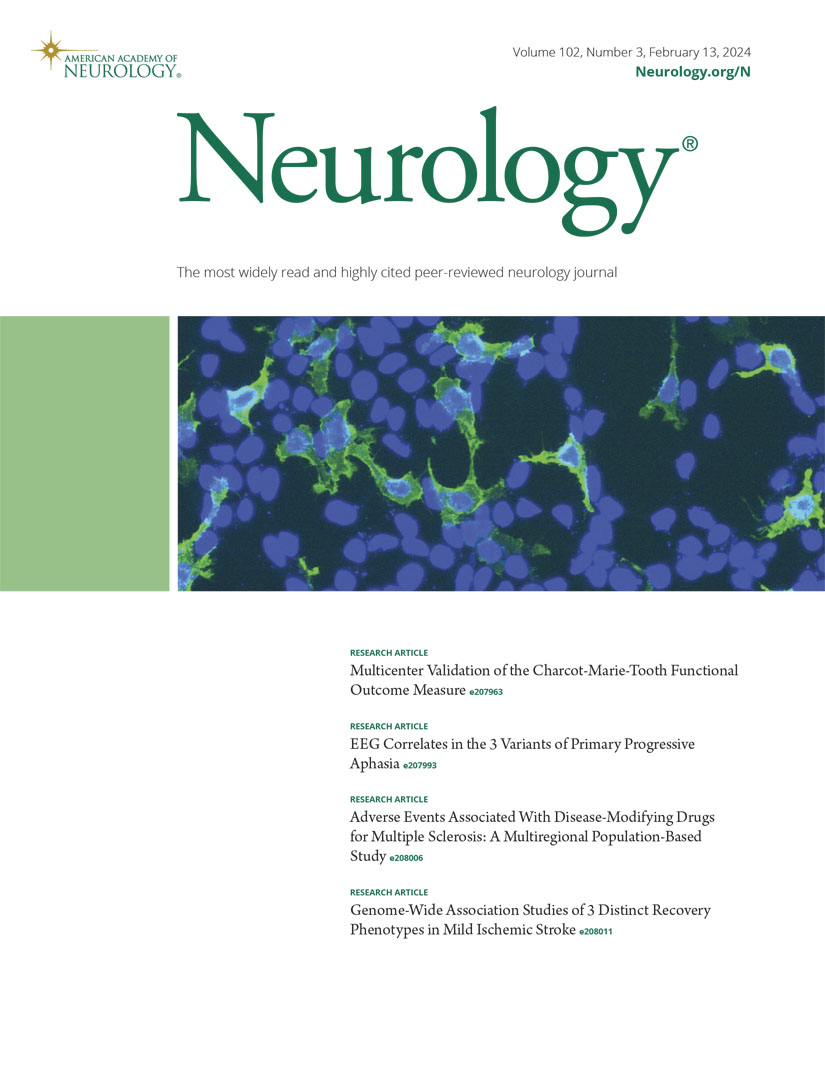Association of Outpatient Follow-Up With 30-Day Readmission After Epilepsy or Seizure Discharge in Medicare Beneficiaries Aged 65 and Older.
IF 7.7
1区 医学
Q1 CLINICAL NEUROLOGY
引用次数: 0
Abstract
BACKGROUND AND OBJECTIVES Older adults are expected to have higher readmission rates after seizure-related hospitalization. We sought to define the 30-day readmission rate for older adults after seizure hospitalization and to examine whether occurrence, timing, or specialization of follow-up with primary or neuro-related care is associated with lower readmission risk. METHODS This is a retrospective cohort study using 2016-2019 Medicare claims data, including adults aged older than 65 years hospitalized with a primary diagnosis of seizure/epilepsy. The primary outcome was readmission within 30 days. Exposure of interest was presence or absence of follow-up and specialty of the follow-up provider. Beneficiaries were followed from 90 days before admission to 30 days after discharge. We defined variables a priori based on literature/clinical judgment and used a least absolute shrinkage and selection operator (LASSO) method to determine factors that were contributing to the data's variance for inclusion in the final model. RESULTS Of 80,620 beneficiaries with admissions for seizure/epilepsy, 17.72% were readmitted within 30 days. Overall, 20.6% saw only primary care, 2.5% neurology only, 0.3% neurosurgery only, and 0.1% epilepsy only, and 5.4% had a combination of visits. Readmission rates differed by follow-up visit status: 22% readmission rate for those with no follow-up and only 6% with any health care visit. Among those with a visit, the readmission rates by specialty were as follows: 8% for primary care alone, 5% for neurology alone, 16% for neurosurgery alone, 1% for epileptology alone, and 2% for those who had seen a combination of these specialties. In our LASSO-selected multivariable model, outpatient follow-up was associated with lower odds of readmission: early (days 1-15) primary care visit (adjusted odds ratio [aOR] 0.49; 95% CI 0.45-0.52, p < 0.001); early neurology visit (aOR 0.39; 95% CI 0.33-0.46, p < 0.001); and later (days 16-30) neurosurgery visit (aOR 0.42; 95% CI 0.27-0.67, p < 0.001), later neurology visit (aOR 0.16; 95% CI 0.13-0.21, p < 0.001), or later primary care visit (aOR 0.16; 95% CI 0.14-0.17, <0.001), all associated with reduced odds of readmission. DISCUSSION We found high rates of readmission in older adults. Outpatient follow-up was associated with reduced odds of readmission. These findings reinforce the importance of discharge planning and suggest that ensuring outpatient follow-up with either primary care or neurology may be an easy intervention to reduce readmissions.65岁及以上医疗保险受益人癫痫或癫痫发作出院后门诊随访与30天再入院的关系
背景与目的老年人癫痫相关住院后的再入院率预计较高。我们试图确定老年人癫痫发作住院后30天的再入院率,并检查初级或神经相关护理随访的发生、时间或专业化是否与较低的再入院风险相关。方法:这是一项回顾性队列研究,使用2016-2019年医疗保险索赔数据,包括65岁以上的住院患者,主要诊断为癫痫发作/癫痫。主要终点为30天内再入院。感兴趣的暴露是是否有随访和随访提供者的专业。随访时间为入院前90天至出院后30天。我们根据文献/临床判断先验地定义变量,并使用最小绝对收缩和选择算子(LASSO)方法来确定导致数据方差的因素,以便纳入最终模型。结果80620名因癫痫发作/癫痫入院的受益人中,17.72%的人在30天内再次入院。总的来说,20.6%的人只看初级保健,2.5%的人只看神经病学,0.3%的人只看神经外科,0.1%的人只看癫痫,5.4%的人综合就诊。再入院率因随访状态而异:没有随访的再入院率为22%,而有任何医疗保健访问的再入院率仅为6%。在就诊的患者中,按专科分类的再入院率如下:单纯初级保健8%,单纯神经病学5%,单纯神经外科16%,单纯癫痫学1%,综合这些专科2%。在lasso选择的多变量模型中,门诊随访与较低的再入院几率相关:早期(1-15天)初级保健就诊(调整优势比[aOR] 0.49;95% CI 0.45-0.52, p < 0.001);早期神经内科就诊(aOR 0.39;95% CI 0.33 ~ 0.46, p < 0.001);之后(第16-30天)神经外科就诊(aOR 0.42;95% CI 0.27-0.67, p < 0.001),之后神经内科就诊(aOR 0.16;95% CI 0.13-0.21, p < 0.001),或之后的初级保健就诊(aOR 0.16;95% CI 0.14-0.17, <0.001),均与再入院几率降低相关。我们发现老年人的再入院率很高。门诊随访与再入院几率降低相关。这些研究结果加强了出院计划的重要性,并表明确保初级保健或神经病学门诊随访可能是减少再入院的简单干预措施。
本文章由计算机程序翻译,如有差异,请以英文原文为准。
求助全文
约1分钟内获得全文
求助全文
来源期刊

Neurology
医学-临床神经学
CiteScore
12.20
自引率
4.00%
发文量
1973
审稿时长
2-3 weeks
期刊介绍:
Neurology, the official journal of the American Academy of Neurology, aspires to be the premier peer-reviewed journal for clinical neurology research. Its mission is to publish exceptional peer-reviewed original research articles, editorials, and reviews to improve patient care, education, clinical research, and professionalism in neurology.
As the leading clinical neurology journal worldwide, Neurology targets physicians specializing in nervous system diseases and conditions. It aims to advance the field by presenting new basic and clinical research that influences neurological practice. The journal is a leading source of cutting-edge, peer-reviewed information for the neurology community worldwide. Editorial content includes Research, Clinical/Scientific Notes, Views, Historical Neurology, NeuroImages, Humanities, Letters, and position papers from the American Academy of Neurology. The online version is considered the definitive version, encompassing all available content.
Neurology is indexed in prestigious databases such as MEDLINE/PubMed, Embase, Scopus, Biological Abstracts®, PsycINFO®, Current Contents®, Web of Science®, CrossRef, and Google Scholar.
 求助内容:
求助内容: 应助结果提醒方式:
应助结果提醒方式:


